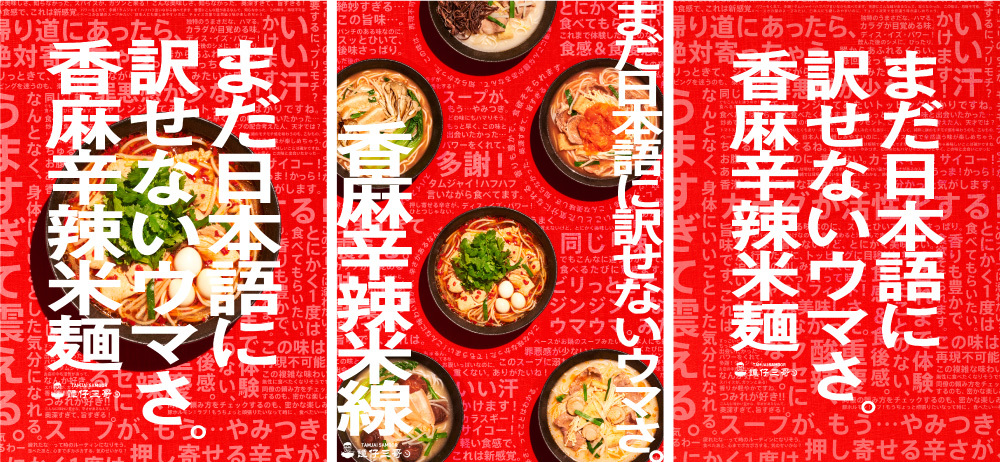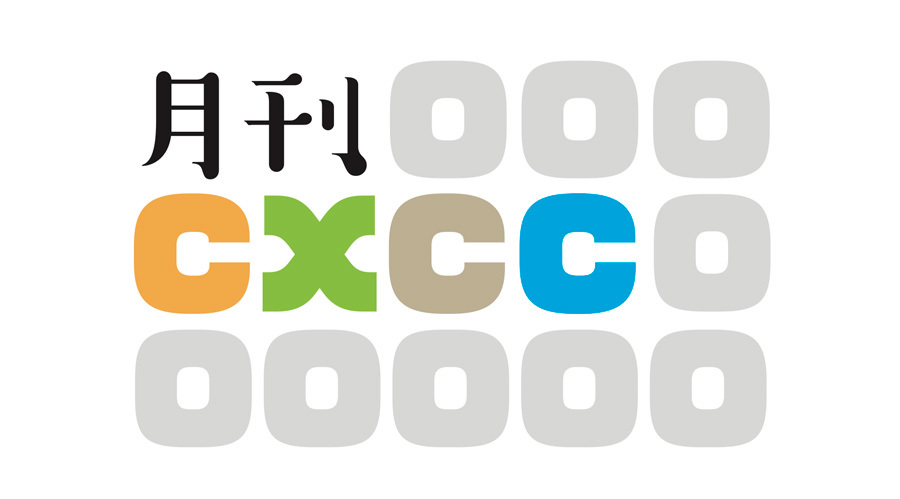The ever-evolving field of CX (Customer Experience).
How can Dentsu Inc.'s creative team contribute to the CX domain, now demanded in every scenario?
To explore this potential, members of Dentsu Inc.'s CX specialist unit, the "CXCC" (Customer Experience Creative Center), share insights on CX and creativity in this series. That is "Monthly CX" ( For more on Monthly CX, click here ).
This time, we spoke with Toru Suwa, Creative Director/Communication Planner, who led the domestic launch campaign for the Hong Kong-based Mieshen Soup Noodle Restaurant " Tam Jai Sam Go " (hereafter Tam Jai Sam Go).
Suwa states, "The key to CX design is crafting messages that prompt customer action and help them personalize the experience." How did he convey the appeal of new flavors to Japanese customers amidst the differing culinary cultures of Hong Kong and Japan?
*CX Creative refers to... using the power of creative to generate valuable new customer experiences. It also denotes the initiatives themselves.
【Toru Suwa Profile】
Dentsu Inc.
Customer Experience Creative Center
Creative Director / Communication Planner
After joining the company, he worked in business production and marketing roles before transitioning to creative work.
From 2016 to 2017, he worked at North Kingdom in Sweden. After returning to Japan, he joined the Customer Experience Creative Center in January 2021.
Handles a wide range of projects from product & service development to branding communications, working under the motto: "Develop strong concepts that transcend single disciplines!"
Major awards include Cannes Lions, D&AD, One Show, AD STARS, Spikes, ADFEST, NYADC, TOKYO ADC, ACC, and others.
【About Tam Jai Sam Go】
A Hong Kong-born soup noodle restaurant featuring rice noodles made from rice and water, known as "Mei Xian" (米線). Operated by Tam Jai International Co. Limited, a group company under Toridoll Holdings, it enjoys immense popularity in Hong Kong. Opened its first Japanese location in Shinjuku on March 31, 2022. As of September 2022, it operates three stores in Tokyo.
The key concept is simple. The sentiment behind "A deliciousness that can't be translated into Japanese yet."
Monthly CX: Please tell us about the overview of your collaboration with Tam Jai Sam Go.
Suwa: Tam Jai Sam Go is a soup noodle restaurant that enjoys immense popularity in Hong Kong. Its signature feature is the use of rice noodles (米線, mǐxiàn), a dish cherished for centuries in China's Yunnan Province. Toridoll Holdings, the parent company behind brands like Marugame Seimen, participated in the venture, opening the first Japanese location in Shinjuku on March 31, 2022. My goal for this launch campaign was to establish this Hong Kong flavor as a natural choice, essentially the "fourth noodle" alongside Japan's udon, soba, and ramen.
Monthly CX: What specific challenges did you face in communicating this unfamiliar food to customers in Japan?
Suwa: The biggest challenge was definitely conveying the taste. The client requested that we "respect the Hong Kong origins of the brand while effectively communicating its flavor."
Tam Jai Sam Go uses the brand keyword "Hyun Ma San La" ( 香麻辛辣 ). This describes a numbing spiciness, a tingling heat, and complex flavors. Hong Kong people apparently understand this keyword immediately, thinking "Ah, that flavor." But for Japanese people, it's unclear what that taste is. The standard approach would be to describe it as "○○ flavor" to make it understandable to Japanese people. However, I felt that if we adjusted it too much for the Japanese market, we wouldn't be able to properly convey the authentic taste, and we might alienate our existing fans.
Monthly CX: What measures did you take?
Suwa: First, we developed the copy "A deliciousness that can't be translated into Japanese yet." Rather than explaining exactly what the flavor is, we decided to deliver it straight. We thought this would spark customers' curiosity about what the flavor might be like and encourage them to take action, like wondering, "How would I translate that?"
At Tam Jai Sam Go, customers can freely choose their soup base, spice level, and toppings. One of the joys is the flexible customization style—discovering your preferred flavor by combining elements, or changing what you eat with it depending on the situation. To convey this appeal, we positioned "A deliciousness that can't be translated into Japanese yet" as both the campaign's key concept and tagline.
Monthly CX: The key visual also features the tagline prominently—a simple yet powerful design.
Suwa: We placed the bowl of noodles front and center, made the catchphrase large, and eliminated unnecessary elements. The background text features customer reactions to Tam Jai Sam Go's rice noodles (mi xian). It conveys how everyone is "translating" the taste, showcasing the depth of flavor and the richness of customization options.
Enabling customers to experience the joy of translating flavors
Monthly CX: Once the tagline was finalized, how did you connect it to the promotion?
Suwa: The tagline was developed with a specific action in mind: "If it's a deliciousness that can't be translated into Japanese, then first get many people to try it and think about how they would translate the taste of Tam Jai Sam Go's rice noodles (mi xian)." So, we organized a tasting event for about 100 people, involving media and influencers, creating an opportunity for them to share the taste and diversity of the rice noodles (mi xian).
Staff from the Hong Kong Tourism Board and guests selected by the board also attended this tasting event. They posted their recommended menu items and toppings on social media. We also rolled out a full range of promotions, including uploading videos on YouTube. As a result, exposure increased, we were featured on TV, and it led to greater brand recognition.
The cooperation from the Hong Kong Tourism Board was also significant. They supported us in various ways, including featuring us on their website, publishing content in the "Chikyu no Arukikata" magazine, and securing exposure in other media outlets.
Monthly CX: Hearing it described as "indescribably delicious" definitely makes you want to give it a try.
Suwa: That's right. We were conscious of making it easier for the media to cover us. Although the brand was completely unknown in Japan, thanks to the promotion, I heard there were lines of 6 to 8 hours at the store on opening day.
Monthly CX: So it really spread to people who hadn't heard of Tam Jai Sam Go before. By the way, how did the original fans react?
Suwa: They were like, "We've been waiting for this!" and accepted it very positively. Apparently, the first people in line were those who had already eaten at Tam Jai Sam Go in Hong Kong. Since both the system and the taste are exactly the same as the original, it was great that the result, including the promotion, didn't disappoint the existing fans.
The key to CX creativity is "evoking the experience for the customer."
Monthly CX: I thought the novelty and appeal of this project really came through in how you described the unknown flavor as "deliciousness that can't be translated into Japanese yet." Hearing it put that way makes you want to define it in words, doesn't it?
Suwa: If you explain it too clearly as "this = that," I think it stops people's thinking right there. The recipient just ends up with "Oh, I see." What we truly aim for is for customers to experience and discover a new taste, so the copy needs to prompt customer action. I call that kind of copy "activation copy."
Monthly CX: The concept of "activation copy" is fascinating. I think it offers a major insight into CX creative—how to shape the customer experience.
Suwa: This campaign was about "Let's all share the experience of translating unknown flavors." I believe copy that evokes an experience has a stronger appeal. To put it more bluntly, unless the original product concept itself involves an experience, it probably won't work very well.
When customers see the copy, they should easily imagine what experience they need to have. Behind the scenes, it should also make it easy for the client and the team to bounce ideas off each other. In creative work, we value both aspects.
Monthly CX: Of course, it makes it easier for customers to relate personally, but the perspective that it also makes it easier to engage the creators is new.
Suwa: Yes, I think it truly requires both sides to come together.
Monthly CX: Is there anything you particularly value in CX creative work?
Suwa: I've always worked with the hope that creative power can make the world just a little bit better. That hasn't changed since I started. Everyone enjoys discovering something new, right? If CX creative can lower the barrier to entering the unknown and make it easier for everyone to casually experience new things, the world should become more enjoyable. The ideal is sharing that concept with everyone involved and working side-by-side with the client.
I've always enjoyed finding the intersection between a product's inherent power and what customers seek. I believe this project succeeded precisely because it effectively connected the authentic Hong Kong flavors with customers' desire to experience something new.
Monthly CX: So this is CX creative that helps customers gain new insights and experiences by embarking on new customer journeys. Thank you for your valuable insights today.
(Editor's Note)
In Monthly CX Issue 10, we introduced the domestic launch campaign case study for the Hong Kong-based Mieshen Soup Noodle Restaurant "Tam Jai Sam Go."
Listening to Mr. Suwa, I realized that traditional copy often leans heavily on messaging and expression. Reaction design, like "activation copy" that not only communicates but also prompts customer action, could be a significant hint for future CX creative.
This interview was conducted in collaboration with 'CX Creative Studio note' ( see here for details on CX Creative Studio note ). We are also working with Dentsu Digital Inc.'s CX creative team, not just the Dentsu CXCC team, to collect and introduce a broader range of case studies. If you're interested, please check that out as well.
If you have requests for future topics or case studies, please send a message to the Monthly CX Editorial Department via the contact page below. Thank you for your continued readership.











